Afterimage of Hiroshima
Many of Sasaki's photographs were taken through fixed point observation of the same place he had photographed several years before. It was to witness and record the change of the city and people's lives. Whenever Sasaki looked through the viewfinder, the image of the completely changed city of Hiroshima after the A-bombing would have crossed his mind. Sasaki's wish for people to remember Hiroshima that day, and to not forget the fact that hundreds of thousands of people died or went missing can be conveyed in his photographs.
| Hondori Shopping Street Hirataya-cho (now, Hondori) 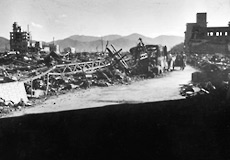 1945View looking east from the area in front of the Hiroshima Branch of Yasuda Bank. Hondori Shopping Street, a main shopping street in Hiroshima, was instantly reduced to rubble. On the right side of the photograph, Kirin Beer Hall and Shimomura Jewelers (crushed by the blast), and in the back left, the Chugoku Shimbun Building appear.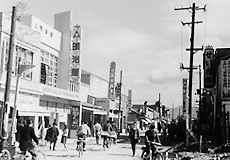
1949Hondori Shopping Street, with stores standing side by side. In 1948, with the inauguration of the "Hiroshima Hondori Commerce Cooperative Society," all-out efforts to revitalize the city were initiated.
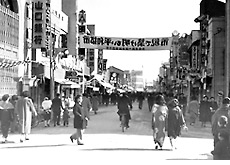
1953Hondori Shopping Street, with a lively atmosphere at the end of the year. An advertisement for a Christmas bargain sale and New Year's decorations appear in this photograph. The phrase "City of Peace" is used in a banner to encourage municipal tax payment. |
Scene from Yamaguchi-cho streetcar stop Yamaguchi-cho
(now, Kanayama-cho)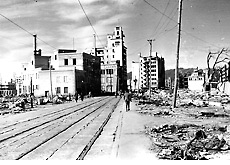 1945View looking west from the neighborhood of a streetcar stop in Yamaguchi-cho (now, Kanayama-cho), approximately 1,100 meters from the hypocenter. Buildings remaining on the left side of Aioi Dori are, from the front, the Hiroshima Branch of Nippon Kangyo Bank, the main and new wings of Chugoku Shimbun, and Fukuya Department Store.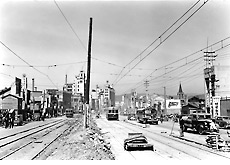 1954Buses with front engine, private automobiles and trucks come and go along Aioi Dori, which was significantly widened to the north. The streetcar tracks temporarily became a four-track line due to the relocation. |
|
| Nagarekawa Church Kami-nagarekawa-cho (now, Teppo-cho) 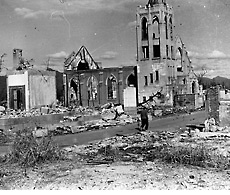 1945Nagarekawa Church, approximately 900 meters from the hypocenter, was reduced to only burned-out walls and a tower after the roof fell in due to the blast and fire. However, the next spring after the A-bombing, services resumed in the ruins and the roof was replaced.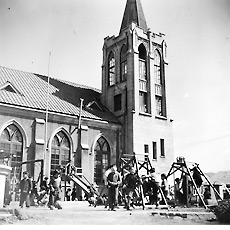
1950At the request of the reverend Kiyoshi Tanimoto who appeared in "Hiroshima,"a full page report by John Hersey in the August 31, 1946 edition of the New Yorker, fundraising activities were conducted internationally and kindergartens and educational facilities were constructed. This was the first kindergarten in Hiroshima City since the war. |
Ekimae-ohashi Bridge Matsubara-cho 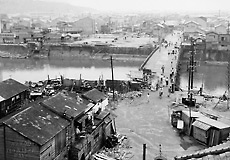 1953View looking southwest on the Enkogawa River from the area in front of Hiroshima Station. Construction of Ekimae-ohashi Bridge was decided along with the newly established Ekimae Dori. A prefabricated panel bridge and a sign telling of the commencement of the construction of a new bridge appear in this photograph.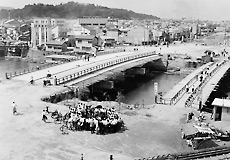
1954Construction of Ekimae-ohashi Bridge began in 1953. However, it was decided due to the budget deficit that the southern half be constructed first, and the northern half be left until later. Shown on the left is the southern half of the bridge, which opened to traffic in March 1954, and is equipped with a wooden parapet.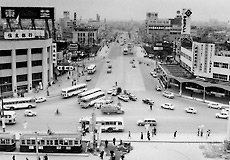 1965Since 1954, the eviction of shack-dwellers from in front of Hiroshima Station had been advanced to the completion of a road leading to Ekimae-ohashi Bridge in 1955. The full opening of Ekimae-ohashi Bridge in August 1956 connected Hiroshima Station with major highways. |
|
